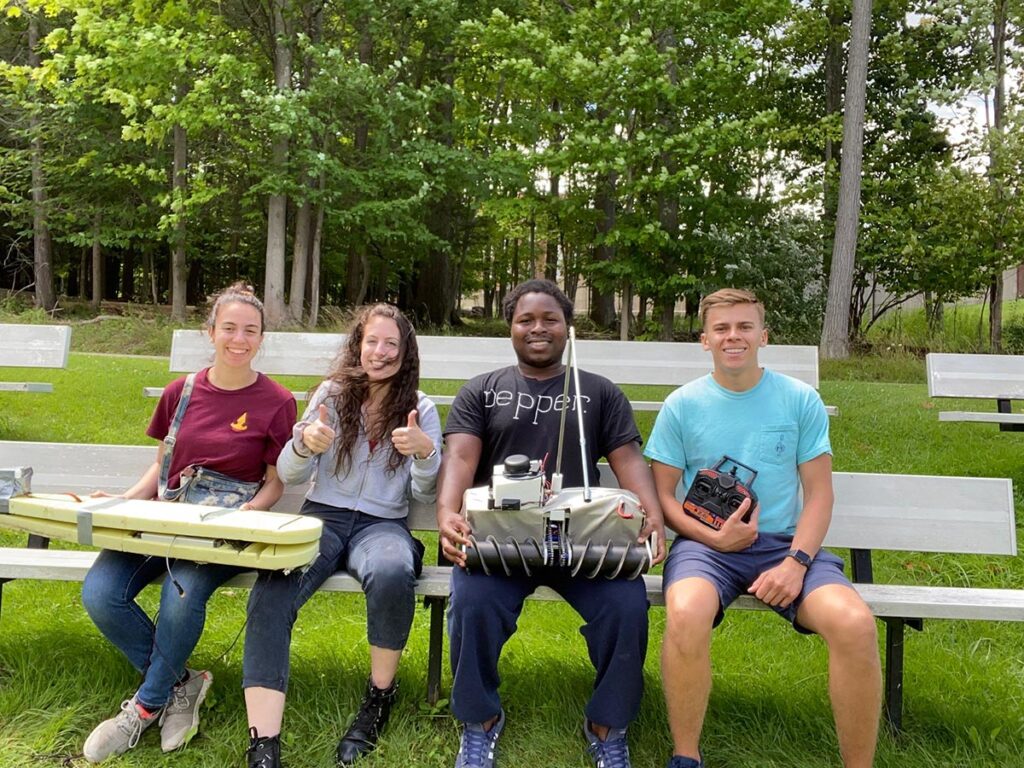Cambodia is a country marked by recent conflict. Decades of war in the late 20th century left indelible scars on the land and its people, and the legacy of those conflicts persists in the form of a landscape strewn with land mines. Mine-related casualties number in the dozens every year, and if land is not cleared of mines, people cannot build on it or farm it, which hinders socioeconomic growth.
Since 1992, demining activities have found and destroyed more than 500,000 mines and more than 2 million pieces of unexploded ordnance, freeing up more than 1,000 square kilometers of land for use. But as many as 4–6 million land mines and other pieces of unexploded ordnance might still be buried across the country, according to the Cambodian Mine Action Centre.
Teams of humans, machines, dogs, and even mine-sniffing rats can clear upward of 4,000 mines per month, but Cambodia’s dense wilderness slows the work. To counteract the thick vegetation, U.S.-based researchers and engineers are working with teams in Cambodia to develop a mine-detecting robot that can more easily navigate the brush and aid local demining efforts.
Cambodia’s Demining Challenge
“Brush clearance is about 70% of the cost of demining a specific area,” explained Garrett Clayton, a mechanical engineer at Villanova University in Pennsylvania. With limited funds available for the work, “that 70% can be expensive.” There is also a continued danger to demining teams and environmental costs to clearing the brush, including loss of wildlife habitats, biodiversity, carbon storage, and other ecosystem services.
“We are working on a robot that can get in under the brush…and then is able to say, ‘Yes, there’s metal content here’ or ‘No, there’s no metal content here,’ so that we can reduce the amount of brush that needs to be cleared.” Reducing the amount of brush to be cleared would reduce the cost of demining, allowing more area to be reclaimed for safe use each month.
Charm and Disarm
The new robot, dubbed Snakebot, looks more like a robotic vacuum cleaner than a traditional demining instrument or drone—a completely intentional design feature.
“Our robot is kind of funny looking. It’s colorful. It’s not this big military-looking contraption,” said Sofia Fasullo, a Binghamton undergraduate, adding that the design was partly inspired by the mine-sniffing HeroRATs, which have been received positively by Cambodians who live near minefields.
Snakebot is less than 50 centimeters long and 25 centimeters tall. It is controlled remotely and maneuvers around on four horizontally oriented screwlike wheels. “A screw mechanism is really good for navigating multiple terrains and getting through the brush,” explained Opeyemi Oladunjoye, a graduate student in mechanical engineering at Villanova University. The prototype can move forward and sideways, and it can rotate. “It’s very maneuverable, very controllable, and very stable.”
As it navigates, Snakebot drags a sensitive magnetometer behind it, keeping the sensor low enough to the ground to detect faint magnetic signals from mines and yet far enough from the robot to minimize interference. “We have tested the robot with the sensor over our simulated landmine areas,” Fasullo said. Those tests, conducted with inert anti-tank and antipersonnel mines planted in fields, show that Snakebot can differentiate between areas that have land mines and those that don’t. Fasullo presented the results of these tests at AGU’s Fall Meeting 2021 on 15 December.
Supplementing Demining Efforts
The researchers’ goal is for the robot to help produce user-friendly maps of areas that do and do not have mines, which demining teams can then use to focus their efforts. That goal includes relying only on software that can be downloaded and used outside academic and research institutions (a condition that excludes the most common mapping tools). Snakebot is meant “to assist existing demining efforts, not to come in and replace anything or anyone,” said Fasullo.

The Snakebot researchers have already been working extensively with humanitarian organizations that operate in Cambodia (like the Golden West Humanitarian Foundation, a sponsor of the project) to design a product that is usable by teams already working on the ground.
Local communities have expressed reluctance to fully rely on technology, including drones or robots, for demining. “There’s no appetite in the demining community to completely remove humans from the ground,” Clayton said.
The researchers are currently working to make the robot even smaller and fine-tune the motor controls and magnetometer. Because of the pandemic, they had to cancel their most recent trip to Cambodia to field-test the robot in its intended use environment, but they are hoping to travel there in 2022 to coordinate with local partners and resume testing.
“Cambodians are using their country’s painful experience to become world leaders in solving the crippling problem of explosive war remnants disposal.”
“Cambodians are using their country’s painful experience to become world leaders in solving the crippling problem of explosive war remnants disposal,” Allen Tan told Voice of America News. Tan, who was the director of Cambodia programs and applied technology at the Golden West Humanitarian Foundation, coordinated with the U.S.-based robotics team out of Phnom Penh. “We’re bringing this deeper and more thorough knowledge to our field, and I like to say democratizing explosive ordnance disposal so any country that has that need can have that need addressed even if they don’t have a multibillion-dollar military budget to do it.”
—Kimberly M. S. Cartier (@AstroKimCartier), Staff Writer


